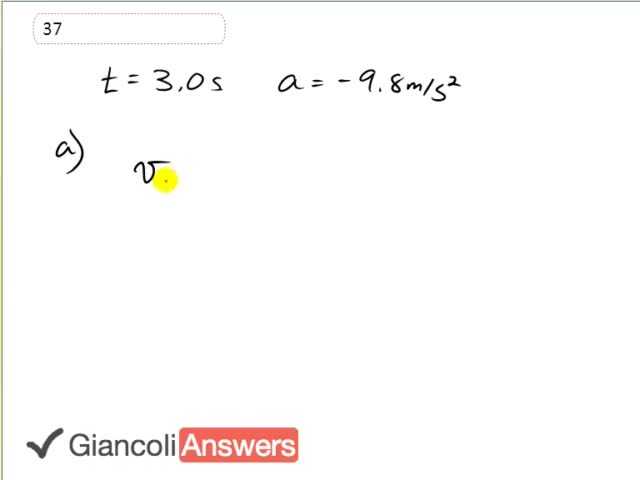
b)

In order to watch this solution you need to have a subscription.
This ball player throws a ball straight up in the air and then catches it three seconds later. We’re going to use this formula: final velocity ‘vf’ equals initial velocity ‘vi’ plus acceleration ‘a’ times time, ‘t’. We know that the velocity that it returns to the player’s hand when it falls back down will be the same speed but opposite direction to its initial velocity, so we’ll say ‘vf’ equals the negative of the initial velocity ‘vi’. Making that substitution: negative ‘vi’ equals ‘vi’ plus ‘a’ times ‘t’, subtracting ‘vi’ from both sides gives us negative two ‘vi’ equals ‘a’ times ‘t’, dividing both sides by negative two gives ‘vi’ equals ‘a’ times ‘t’ over negative two. Substituting in numbers: negative nine point eight meters per second squared times three point zero seconds divided by two giving an initial velocity of fourteen point seven meters per second which we’ll round off to fifteen meters per second for two significant figures. Part be asks what is the height that it reached. We can say that the average speed is: final speed plus the initial speed over two times time. I’m trying not to use this result from part a in part b because it’s always best to refer only to original data as much as possible. The time we want here is the time to the maximum height, ‘ti’ which will be half of the total time that the ball spends in the air, so ‘t’ over two which is three point zero seconds divided by two which is one and a half seconds. The final speed at maximum height will be zero meters per second at its maximum height so‘d’ is: zero plus the initial speed of fourteen point seven divided by two times one point five seconds giving a maximum height of eleven meters. In the 5th Edition the time the ball spends in the air is three point three seconds, so substituting the initial speed must have been sixteen point one seven meters per second which we’ll round of to sixteen meters per second then substituting to give a maximum height of thirteen meters for the 5th Edition.
Why is the final velocity not equal to zero since he catches the ball?
Hi rohanblazers,
The "final" moment is immediately just before catching the ball.
Cheers,
Mr. Dychko